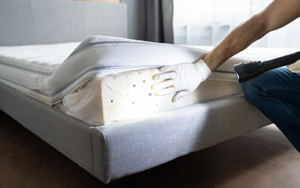
Bed bug infestations with sustaining populations in classrooms are rare because schools are generally poor environments for bed bug survival and reproduction. However, periodic introductions of bed bugs into classes occur more often due to the increasing frequency of bed bugs in homes.
Bed bugs can crawl onto or off of a person, or their belongings, at any time making them excellent hitchhikers. In fact, the most common way for bed bugs to enter a school is through “hitchhiking” from an infested site. Usually this is from a student, staff or teacher’s home which has a bed bug infestation. Bed bugs are not associated with uncleanliness or socioeconomic status, but this insect has a substantial social stigma. While teachers and staff can be more easily addressed, dealing with students or parents can be challenging, especially if the family cannot afford proper control measures or their landlord refuses to properly treat their home.
Steps schools can follow if a student’s home is known to have a bed bug infestation:
- Provide the student with educational materials they can take home with them.
- Send a letter to the student’s parent or guardian requesting that they take steps to reduce the risk of bed bugs being transported to school.
- Send a letter to all parents with children in the affected classroom.
- Provide the student with plastic bags or a plastic bin in which to store their belongings while at school.
- Isolate the student’s belongings.
- Reduce the number of items that the student has to transport between school and home.
- Regularly inspect the student’s desk and or locker for bed bugs.
- Avoid accumulation of clothes, shoes and boots in the classroom.
Preventing Bed Bugs in the School:
Providing proactive bed bug education is the best way to prevent a bed bug infestation in schools.
- Provide educational materials to staff and parents/guardians.
- Keep the facility clean and uncluttered. Bed Bugs are not associated with uncleanliness, but a clean facility makes it easier to detect bed bugs before an infestation gets established.
- If children take naps at school, regularly put the bedding in the dryer on a high setting for at least 30 min. This will kill all stages of bed bug development. Dress up clothes or theater costumes should also be regularly put through the dryer.
- Regularly clean and inspect the following: lost-and-found, sleeping areas, upholstered furniture, and wall mounted items (pictures, clocks, signs, mirrors, etc.).
- Store items (bedding, clothes, coats, bags) in clear plastic containers when possible.
- Consider periodic inspection by a bed bug detecting canine, if bed bugs are consistently an issue in the population you serve.
Recommendations for parents to follow at home:
- Parents should regularly inspect their children’s belongings for hitchhiking bed bugs.
- Limiting the number of items children bring home from school.
- Regularly checking backpacks, jackets and clothing after kids return home and keeping these items in a separate area of the house.
- Wash and dry cloth items returning from school in hot temperatures.
- Inspecting your car for signs of bed bugs, like shed exoskeletons and blood stains.
- If the school has reported an infestation, consider housing all related items in a sealed plastic bin.
- Ask school administrators whether they have bed bug detection and elimination plans.
Whether your kids are in school or you work in a school yourself, it is important to keep yourself educated about bed bugs and prevention.
Get more information on bed bugs here.
Need a pest control estimate?
We'll call you! Our representatives are fast and friendly.
How to Prevent Bed Bugs in Schools and Avoid Bringing Them Home in Wisconsin
Serving Wisconsin





